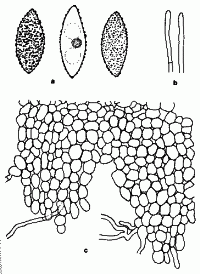|
 Tarzetta jafneospora Tarzetta jafneospora
BiostatusPresent in region - Indigenous. Endemic
Images (click to enlarge)
Caption: FIG. 1. Tarzetta jafneospora (holotype):a. three ascospores with ornamentations
stained in cotton blue in lactic acid, middle spore in
optical section showing guttules and the single, central nucleus staining in acetocarmine,
x1580. b. two pa |
Article: Zhuang, W.Y.; Korf, R.P. (1987). A new species of Tarzetta (Pezizales) from New Zealand. Mycotaxon 28(2): 365-368.
Description: Apothecium cupulate, subsessile to substipitate, 4-12 mm in diam when dry, margin crenate,
hymenium yellow to orange, receptacle yellowish beige when dry, surface strongly pustulate.
Ectal excipulum of textura angularis to textura globulosa, 75-120 µm thick, cells ovoid to
isodiametric, hyaline; cells at margin arranged in long, parallel hyphae which extend beyond
the hymenium; cells of pustules hyaline, ovoid or subspherical, loosely interconnected,
arranged irregularly in chains; a few cylindrical hyphae growing from outermost cells,
septate, hyaline and thin-walled, ca. 5.5-7.5 µm wide. Medullary excipulum of textura
intricata, 185-220 µm thick, hyphae hyaline, ca. 5.5 µm wide. Subhymenium not clear.
Asci 8-spored, cylindrical, J- in Melzer's Reagent, ca. 325-340 x 13.2-18.3 µm, croziers not seen.
Ascospores uniseriate, subfusoid, biguttulate, uninucleate, nucleus staining in acetocarmine,
20.5-25.2 x 9.0-10.8 µm, with numerous small warts, warts less than 0.5 µm in diam, often
irregularly interconnected. Paraphyses filiform, slender, 2.0-2.8 µm wide, not exceeding asci.
Habitat: HABITAT: On sandy soil, rarely on rotten wood.
Notes: NOTES: The genus Tarzetta has been placed in the tribe Jafneeae by Korf (1972) and in Otideeae by
Dennis (1978). Three genera, Geopyxis, Jafnea, and Otidea, have been thought to be similar
to Tarzetta in different aspects by many authors (Dennis, 1978; Eckblad, 1968; Harmaja,
1974; Korf, 1972, 1973; Rifai, 1968). These genera can be distinguished on the basis of the
shape and structure of apothecium, the presence of brown hairs or hyaline hyphae on the
receptacle surface, the shape and guttulation of ascospores, the stainability of nuclei in
acetocarmine, and the presence of spore ornamentations. The species from New Zealand, to a
certain extent, shares the characters of both Jafnea and Tarzetta. It has the pustulate,
substipitate apothecium, crenate margin, a few hyaline hyphae on the receptacle, angular to
globose cells in the ectal excipulum, and the interwoven hyphae in the medullary excipulum,
which are characters of Tarzetta, but the fusoid, marked ascospores recall species of Jafnea.
This reminds us of the situation in Trichophaea geoporoides, which we treated as a
Trichophaea species though it is similar to Geopora in some ways (Korf & Zhuang, 1985). In
avoiding description of a new genus for this species, we choose to place more emphasis on
anatomical structure than on spore characteristics, and describe it as a species of Tarzetta, in a
genus that clearly needs to be monographed.
|